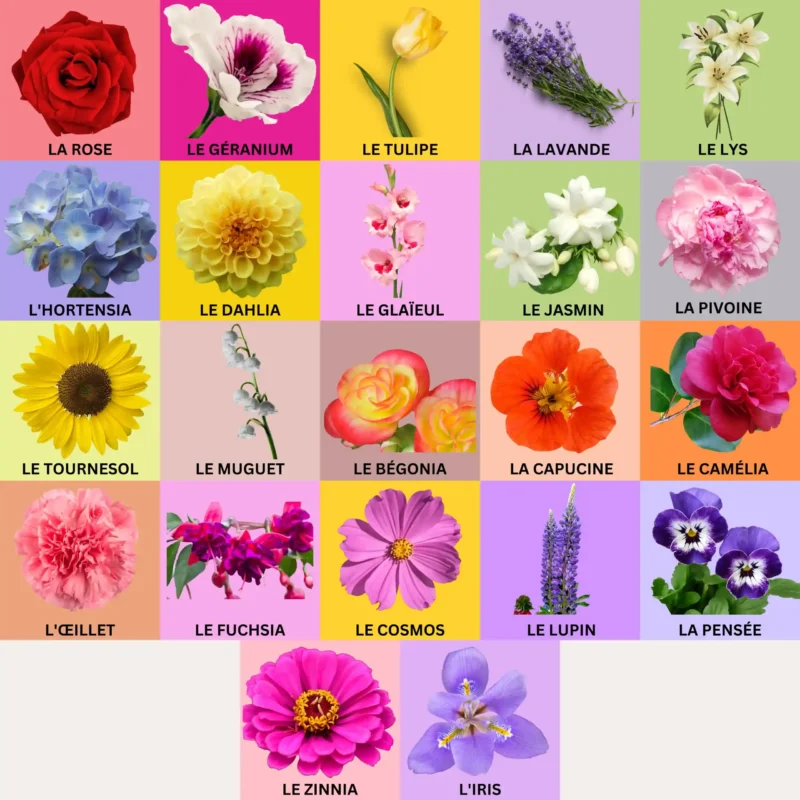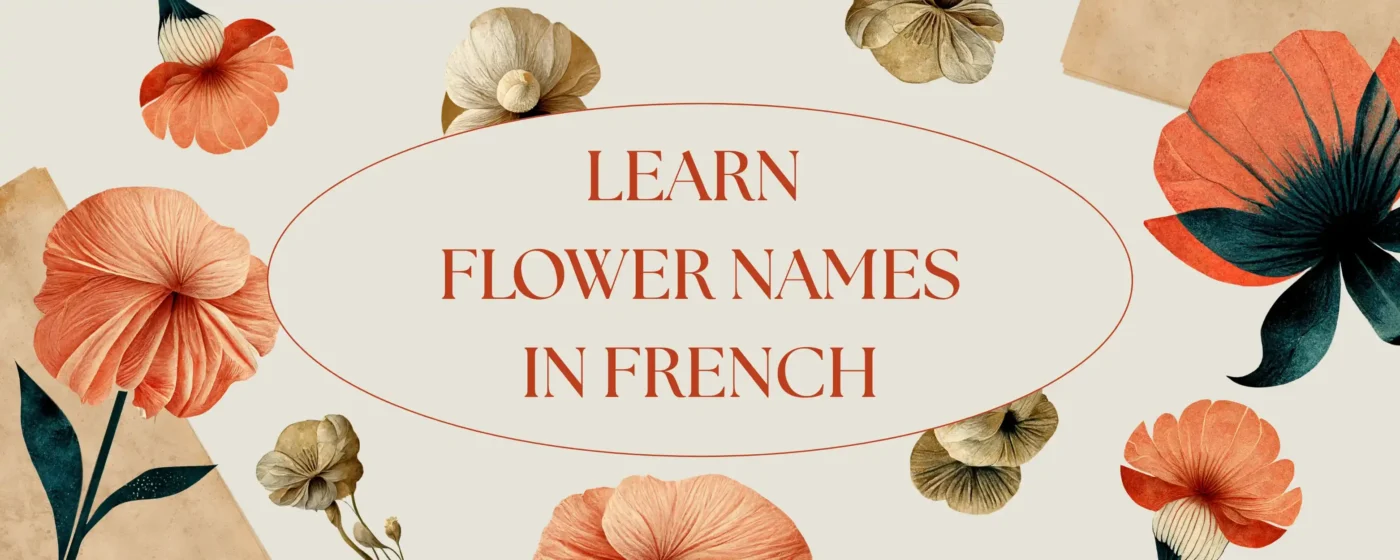Flowers hold a special place in French culture and language, symbolizing beauty, love, and tradition. This article aims to help readers learn and remember the names of various flowers in French, enriching their vocabularies and deepening their appreciation for this vibrant aspect of French-speaking regions.
Key Takeaways
- Learning the names of French flowers such as the “fleur-de-lys,” wild blooms, and garden favourites helps you connect with both the language and its culture.
- Knowing common wildflowers and garden plants makes it easier to describe nature and everyday beauty in French with confidence.
- Exploring floral vocabulary brings a sense of charm to your learning journey and helps your French sound more natural and expressive.
Importance of Flowers in French Culture
Flowers are deeply embedded in French culture, symbolizing love, beauty, and respect. They play a crucial role in celebrations such as weddings, holidays, and commemorations. Historically, French gardens, like those of Versailles, highlight the nation’s passion for horticulture. In everyday life, flowers brighten homes, cafés, and markets, reflecting the French appreciation for nature’s elegance and seasonal beauty.
National Flower of France
France’s national flower is the fleur-de-lys, often mistakenly translated as “lily flower.” However, it is actually a stylized iris. The fleur-de-lys has deep cultural and historical significance, symbolizing French royalty and appearing in the country’s coat of arms and emblems since the Middle Ages. It represents purity, light, and perfection, and remains a powerful symbol of French heritage and identity.
Other Popular Flowers
Here are some popular flowers in France, including wildflowers and garden varieties, along with their French names, articles, and pronunciations:
Wildflowers of France
| French Name | English Name | Pronunciation |
|---|---|---|
| Le coquelicot | Poppy | /kɔ.kli.ko/ |
| La marguerite | Daisy | /maʁ.ɡə.ʁit/ |
| Le bleuet | Cornflower | /blø.ɛ/ |
| La pâquerette | Common Daisy | /pa.kʁɛt/ |
| Le bouton d’or | Buttercup | /bu.tɔ̃ d‿ɔʁ/ |
| Le pissenlit | Dandelion | /pi.sɑ̃.li/ |
| La digitale | Foxglove | /di.ʒi.tal/ |
| La primevère | Primrose | /pʁi.mə.vɛʁ/ |
| Le chèvrefeuille | Honeysuckle | /ʃɛ.vʁə.fœj/ |
| La campanule | Bellflower | /kɑ̃.pa.nyl/ |
| Le myosotis | Forget-me-not | /mjo.zo.tis/ |
| La violette | Violet | /vjo.lɛt/ |
| L’anémone des bois | Wood Anemone | /a.ne.mɔn de bwa/ |
| Le lys des champs | Field Lily | /lis de ʃɑ̃/ |
| Le souci | Marigold | /su.si/ |
| La ciguë | Hemlock | /si.ɡy/ |
| Le genêt | Broom | /ʒə.nɛ/ |
| Le trèfle | Clover | /tʁɛ.fl/ |
| Le liseron | Bindweed | /li.zə.ʁɔ̃/ |
| La pulmonaire | Lungwort | /pyl.mo.nɛʁ/ |
| Le cardamine | Cuckoo Flower | /kaʁ.da.min/ |
| Le salsifis | Goatsbeard | /sal.si.fi/ |
| Le chardon | Thistle | /ʃaʁ.dɔ̃/ |

Common Garden Flowers
| French Name | English Name | Pronunciation |
|---|---|---|
| La rose | Rose | /ʁoz/ |
| Le géranium | Geranium | /ʒe.ʁa.njɔm/ |
| Le tulipe | Tulip | /ty.lip/ |
| La lavande | Lavender | /la.vɑ̃d/ |
| Le lys | Lily | /lis/ |
| L’hortensia | Hydrangea | /ɔʁ.tɑ̃.sja/ |
| Le dahlia | Dahlia | /da.lja/ |
| Le glaïeul | Gladiolus | /ɡla.jœl/ |
| La pivoine | Peony | /pi.vwan/ |
| Le jasmin | Jasmine | /ʒas.mɛ̃/ |
| Le tournesol | Sunflower | /tuʁ.nə.sɔl/ |
| Le muguet | Lily of the Valley | /my.ɡɛ/ |
| Le bégonia | Begonia | /be.ɡɔ.nja/ |
| La capucine | Nasturtium | /ka.py.sin/ |
| Le camélia | Camellia | /ka.me.lja/ |
| L’œillet | Carnation | /œ.jɛ/ |
| Le fuchsia | Fuchsia | /fy.ʃja/ |
| Le cosmos | Cosmos | /kɔz.mɔs/ |
| Le lupin | Lupine | /ly.pɛ̃/ |
| La pensée | Pansy | /pɑ̃.ze/ |
| Le zinnia | Zinnia | /zin.nja/ |
| L’iris | Iris | /i.ʁis/ |

Stop Guessing, Start Speaking!
With our expert tutors, you’ll master the words you need to speak French confidently!
Flower-Related Vocabulary
Here are some additional floral vocabulary terms to help readers describe flowers more comprehensively in French:
| English Term | French Term | Pronunciation |
|---|---|---|
| Petal | Le pétale | /pe.tal/ |
| Stem | La tige | /tiʒ/ |
| Roots | Les racines | /ʁa.sin/ |
| Leaf | La feuille | /fœj/ |
| Flower | La fleur | /flœʁ/ |
| Bud | Le bourgeon | /buʁ.ʒɔ̃/ |
| Blossom | La floraison | /flɔ.ʁɛ.zɔ̃/ |
| Bouquet | Le bouquet | /bu.kɛ/ |
| Garden | Le jardin | /ʒaʁ.dɛ̃/ |
| Vase | Le vase | /vaz/ |
| Seed | La graine | /ɡʁɛn/ |
| Blossom (verb) | Fleurir | /flœ.ʁiʁ/ |
| To grow | Pousser | /pu.se/ |
| Fragrance | Le parfum | /paʁ.fœ̃/ |
| Thorns | Les épines | /e.pin/ |
| Soil | Le sol | /sɔl/ |
| Garden bed | La plate-bande | /plat.bɑ̃d/ |
| Watering can | L’arrosoir | /aʁo.zwaʁ/ |
| Greenhouse | La serre | /sɛʁ/ |
| Pollination | La pollinisation | /pɔ.li.ni.za.sjɔ̃/ |
| Bloom | Épanouir | /e.pa.nwiʁ/ |
| Wilted | Flétri(e) | /flɛ.tʁi/ |
| Annual | Annuelle | /a.nɥɛl/ |
| Perennial | Vivace | /vi.vas/ |
| Fertilizer | L’engrais | /ɑ̃.ɡʁɛ/ |
Etiquette for Giving Flowers in French Culture
In French culture, giving flowers follows specific etiquette. Flower colors have distinct meanings: red signifies love, white symbolizes purity, and yellow can imply jealousy. Always present an odd number of flowers, except for 13, which is considered unlucky. Avoid chrysanthemums, as they are associated with funerals. When invited to someone’s home, a bouquet is a thoughtful gesture, demonstrating appreciation and respect.
Les Muguets (Lily of the Valley)
Les muguets, or Lily of the Valley, hold significant cultural importance in France, particularly in the month of May. These delicate white flowers, known for their sweet fragrance, are traditionally given on May 1st, known as La Fête du Muguet (Lily of the Valley Day) or Labor Day. This tradition dates back to 1561 when King Charles IX received a lily of the valley as a token of good luck and decided to offer it to the ladies of his court every year.
Conclusion
This article covered the cultural significance of flowers in France, the national flower, popular wildflowers and garden flowers, essential floral vocabulary, and gifting etiquette. Practice your new vocabulary and explore the world of French flowers. Embrace the beauty and richness of learning these floral terms to enhance your French experience.
Learn about Animal Names & Bird Names in French here.
Frequently Asked Questions
Q1: What is the feminine flower in French?
Ans: In French, the word for flower is “fleur,” which is feminine. This means that when describing flowers in French, you use feminine articles and adjectives. For example, “a beautiful flower” translates to “une belle fleur.”
Q2: What is the French name for roses?
Ans: The French name for roses is “les roses.” Roses are highly popular in French culture, symbolizing love and passion. They are often featured in gardens, bouquets, and special occasions.
Q3: What is the national flower of France?
Ans: The national flower of France is the fleur-de-lys, a stylized iris rather than a lily. It holds significant historical and cultural importance, symbolizing French royalty and heritage. Discover more about the iconic French flowers at La Forêt French Class.
Q: What is Paris’ flower?
Ans: Paris is often associated with the rose, symbolizing romance and beauty, fitting the city’s reputation as the “City of Love.” Roses are a common sight in Parisian gardens and florists. For a taste of Parisian charm, visit La Forêt to find exquisite rose arrangements.





